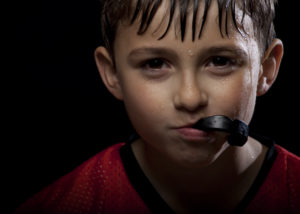 If you have a child involved in sports at any age, this is an important consideration for you to take regarding your child’s health, appearance, and your financial security. Properly diagnosed, prescribed, and fashioned athletic mouthguards are essential to the prevention of oral and facial damage and brain trauma in a sports environment. An estimated 5 million kids will lose a tooth to athletic injury this year. The National Youth Sports Foundation for the Prevention of Athletic Injuries estimates a $10,000-15000 lifetime average expenditure for these types of injuries. The ADA estimates that athletic mouthguards prevent more than 200,000 injuries per year in high school and college sports alone.
If you have a child involved in sports at any age, this is an important consideration for you to take regarding your child’s health, appearance, and your financial security. Properly diagnosed, prescribed, and fashioned athletic mouthguards are essential to the prevention of oral and facial damage and brain trauma in a sports environment. An estimated 5 million kids will lose a tooth to athletic injury this year. The National Youth Sports Foundation for the Prevention of Athletic Injuries estimates a $10,000-15000 lifetime average expenditure for these types of injuries. The ADA estimates that athletic mouthguards prevent more than 200,000 injuries per year in high school and college sports alone.
All Mouthguards are Not the Same
The term “mouthguard” unfortunately denotes a wide array of products. Currently more than 90% of mouthguards in the US are store bought and only 10% are custom fabricated by a dentist. Stock mouthguards and the “boil and bite” mouthguards are the most common. These mouthguards suffer from many problems. First, they are bulky and uncomfortable. This makes the chance of that athlete utilizing it properly and consistently much less. They also do not provide much protection because they are not custom fit to the athlete’s mouth. This causes wiggle room in the mouthguard and that can actually be counterproductive. This is a picture of a stock mouthguard after only several weeks of use:
How a Custom Fabricated Athletic Mouthguard is Made
Your dentist can recommend the best mouthguard for each particular athlete. Generally an upper tray is made but sometimes both upper and lower trays are utilized. First, your dentist will make an impression of the athlete’s teeth and a mouth guard is then molded over the model using a special material. This provides a firm and custom fit for that particular dental arch.
A properly fitted mouthguard needs to be comfortable, properly protective, resistant to tear, constructed out of the proper material, needs to be comfortable and not bulky, and have enough thickness in the critical areas. It is extremely important to properly protect your child from these injuries.



